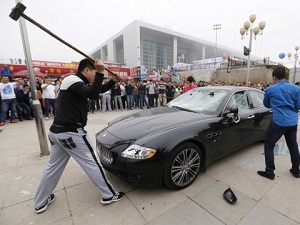
REUTERS/Stringer China
If there has been one prediction made more than any other over the past couple of decades, it’s that China’s miraculous economy is headed for a fall.
China bears have pointed to a long list of disasters-in-the-making, from questionable economic statistics to skyrocketing real-estate prices to ghost cities to centrally planned growth, corruption, pollution. civil unrest, debt.
And yet, despite all of these concerns, China’s economic machine has just kept chugging along.
But this time it’s going to be different!, says an analyst from Fitch. This time, China really is screwed.
According to Ambrose Evans-Pritchard of the Telegraph, Fitch analyst Charlene Chu has concluded that China’s growth is being fueled by a credit bubble that is unlike anything the modern world has ever seen. This debt bubble is leading to massive overbuilding, Chu says. And when it finally bursts, as debt bubbles always do, China will be looking at a Japan-style depression and deflation.
Given the number of China doom prophesies that have been made over the past two decades, you can be forgiven for rolling your eyes at this one and moving on. But Chu does cite some startling statistics, including the claim that China’s debt-to-GDP ratio has quietly shot up to more than 200% and that each additional yuan borrowed is producing ever less growth. If there’s any hard law of finance, it’s that what can’t go on forever won’t. And borrowing at this rate relative to economic growth can’t go on forever.
That said, as always, the key question is “when?”
At some point, China’s economy is almost certainly going to go through the same sort of violent setbacks that every economy goes through, including the economy with which China’s is compared–the U.S. economy.
The growth of the U.S. economy over the past century has been nothing short of miraculous. But it has been anything but a smooth ride. Amidst its decades of expansion, the U.S. has gone through several decade-long periods of depression and stagnation, often following debt buildups just like the one China appears to be experiencing. In fact, the U.S. economy is still struggling to move past its latest debt-fueled bubble, the housing boom that turned to bust five years ago and took the country down with it.
If China manages to avoid this boom-bust pattern forever, the country’s resurgence really will be miraculous. And what is likely to send the Chinese economy into its own depression is exactly the sort of debt buildup that Chu describes.
But booms often last much longer than most analysts think they can. And unless or until we know exactly when China’s boom will end–which, if history is a guide, we won’t know until after the fact–it’s hard to make decisions based on this forecast.
Yes, at some point, China’s economy will crack. Alas, no one knows when.
Henry Blodget
Analyst Says China’s Credit Bubble Is Unlike Anything In Modern History
China’s shadow banking system is out of control and under mounting stress as borrowers struggle to roll over short-term debts, Fitch Ratings has warned.
The agency said the scale of credit was so extreme that the country would find it very hard to grow its way out of the excesses as in past episodes, implying tougher times ahead.
“The credit-driven growth model is clearly falling apart. This could feed into a massive over-capacity problem, and potentially into a Japanese-style deflation,” said Charlene Chu, the agency’s senior director in Beijing.
“There is no transparency in the shadow banking system, and systemic risk is rising. We have no idea who the borrowers are, who the lenders are, and what the quality of assets is, and this undermines signaling,” she told The Daily Telegraph.
While the non-performing loan rate of the banks may look benign at just 1pc, this has become irrelevant as trusts, wealth-management funds, offshore vehicles and other forms of irregular lending make up over half of all new credit. “It means nothing if you can off-load any bad asset you want. A lot of the banking exposure to property is not booked as property,” she said.
Concerns are rising after a string of upsets in Quingdao, Ordos, Jilin and elsewhere, in so-called trust products, a $1.4 trillion (£0.9 trillion) segment of the shadow banking system.
Bank Everbright defaulted on an interbank loan 10 days ago amid wild spikes in short-term “Shibor” borrowing rates, a sign that liquidity has suddenly dried up. “Typically stress starts in the periphery and moves to the core, and that is what we are already seeing with defaults in trust products,” she said.
Fitch warned that wealth products worth $2 trillion of lending are in reality a “hidden second balance sheet” for banks, allowing them to circumvent loan curbs and dodge efforts by regulators to halt the excesses.
This niche is the epicentre of risk. Half the loans must be rolled over every three months, and another 25pc in less than six months. This has echoes of Northern Rock, Lehman Brothers and others that came to grief in the West on short-term liabilities when the wholesale capital markets froze.
Mrs Chu said the banks had been forced to park over $3 trillion in reserves at the central bank, giving them a “massive savings account that can be drawn down” in a crisis, but this may not be enough to avert trouble given the sheer scale of the lending boom.
Overall credit has jumped from $9 trillion to $23 trillion since the Lehman crisis. “They have replicated the entire US commercial banking system in five years,” she said.
The ratio of credit to GDP has jumped by 75 percentage points to 200pc of GDP, compared to roughly 40 points in the US over five years leading up to the subprime bubble, or in Japan before the Nikkei bubble burst in 1990. “This is beyond anything we have ever seen before in a large economy. We don’t know how this will play out. The next six months will be crucial,” she said.
The agency downgraded China’s long-term currency rating to AA- debt in April but still thinks the government can handle any banking crisis, however bad. “The Chinese state has a lot of firepower. It is very able and very willing to support the banking sector. The real question is what this means for growth, and therefore for social and political risk,” said Mrs Chu.
“There is no way they can grow out of their asset problems as they did in the past. We think this will be very different from the banking crisis in the late 1990s. With credit at 200pc of GDP, the numerator is growing twice as fast as the denominator. You can’t grow out of that.”
The authorities have been trying to manage a soft-landing, deploying loan curbs and a high reserve ratio requirement (RRR) for banks to halt property speculation. The home price to income ratio has reached 16 to 18 in many cities, shutting workers out of the market. Shadow banking has plugged the gap for much of the last two years.
However, a new problem has emerged as the economic efficiency of credit collapses. The extra GDP growth generated by each extra yuan of loans has dropped from 0.85 to 0.15 over the last four years, a sign of exhaustion.
Wei Yao from Societe Generale says the debt service ratio of Chinese companies has reached 30pc of GDP – the typical threshold for financial crises — and many will not be able to pay interest or repay principal. She warned that the country could be on the verge of a “Minsky Moment”, when the debt pyramid collapses under its own weight. “The debt snowball is getting bigger and bigger, without contributing to real activity,” she said.
The latest twist is sudden stress in the overnight lending markets. “We believe the series of policy tightening measures in the past three months have reached critical mass, such that deleveraging in the banking sector is happening. Liquidity tightening can be very damaging to a highly leveraged economy,” said Zhiwei Zhang from Nomura.
“There is room to cut interest rates and the reserve ratio in the second half,” wrote a front-page editorial today in China Securities Journal on Friday. The article is the first sign that the authorities are preparing to change tack, shifting to a looser stance after a drizzle of bad data over recent weeks.
The journal said total credit in China’s financial system may be as high as 221pc of GDP, jumping almost eightfold over the last decade, and warned that companies will have to fork out $1 trillion in interest payments alone this year. “Chinese corporate debt burdens are much higher than those of other economies. Much of the liquidity is being used to repay debt and not to finance output,” it said.
It also flagged worries over an exodus of hot money once the US Federal Reserve starts tightening. “China will face large-scale capital outflows if there is an exit from quantitative easing and the dollar strengthens,” it wrote.
The journal said foreign withdrawals from Chinese equity funds were the highest since early 2008 in the week up to June 5, and withdrawals from Hong Kong funds were the most in a decade.
Ambrose Evans-Pritchard, The Daily Telegraph












































